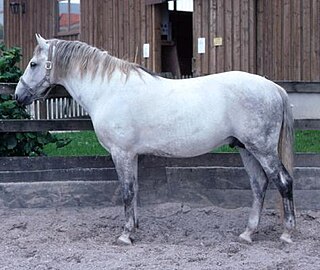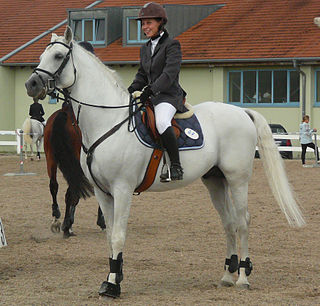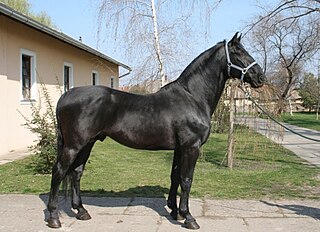
Trakehner is a light warmblood breed of horse, originally developed at the East Prussian state stud farm in the town of Trakehnen from which the breed takes its name. The state stud was established in 1731 and operated until 1944, when the fighting of World War II led to the annexing of East Prussia by Russia, and the town containing the stud renamed as Yasnaya Polyana.

The Byerley Turk, also spelled Byerly Turk, was the earliest of three stallions that were the founders of the modern Thoroughbred horse racing bloodstock.

The Godolphin Arabian, also known as the Godolphin Barb, was an Arabian horse who was one of three stallions that founded the modern Thoroughbred. He was named after his best-known owner, Francis Godolphin, 2nd Earl of Godolphin.

The Arabian or Arab horse is a breed of horse with historic roots on the Arabian Peninsula. With a distinctive head shape and high tail carriage, the Arabian is one of the most easily recognizable horse breeds in the world. It is also one of the oldest modern breeds. Although modern DNA cannot trace breed purity in the modern population beyond 200 years, there is archaeological evidence of horses in the Middle East with landrace characteristics that resemble modern Arabians dating back 3,500 years. Throughout history, Arabian horses have spread around the world by both war and trade, used to improve other breeds by adding speed, refinement, endurance, and strong bone. Today, Arabian bloodlines are found in almost every modern breed of riding horse.

The Lipizzan or Lipizzaner is a European breed of riding horse developed in the Habsburg Empire in the sixteenth century. It is of Baroque type, and is powerful, slow to mature and long-lived; the coat is usually gray.
Alois Podhajsky was an Austrian soldier and Equestrian, riding instructor and Olympic medal-winner in dressage. He was the director of the Spanish Riding School in Vienna, Austria and competed at the 1936 Summer Olympics and the 1948 Summer Olympics.

A stud farm or stud in animal husbandry is an establishment for selective breeding of livestock. The word "stud" comes from the Old English stod meaning "herd of horses, place where horses are kept for breeding". Historically, documentation of the breedings that occur on a stud farm leads to the development of a stud book. Male animals made available for breeding to outside female animals are said to be "standing at stud", or at "stud service", referencing the relatively high probability that they are kept at a stud farm.

The Kladruber is the oldest Czech horse breed and one of the world's oldest horse breeds. It is considered very rare. The chief breeder and the keeper of the studbook is the National Stud at Kladruby nad Labem in the Czech Republic where Kladrubers have been bred for more than 400 years. Kladrubers have always been bred to be a galakarossier – a heavy type of carriage horse for the court of the House of Habsburg.

"Al Khamsa" (الخمسة) is a designation applied to specific desert-bred bloodlines of the Arabian horse considered particularly "pure" by Arabian horse breeders, who sometimes also describe such lines with by use of the Arabic word asil, meaning "pure". It also refers to a mythical origin story of the breed

The Shagya Arabian is a horse breed which was developed in the Austro-Hungarian Empire during the 19th century at the Bábolna, Mezőhegyes, Radautz, Piber, and Topolcianky studs. Today it is most often seen in the Czech Republic, Austria, Romania, the former Yugoslavian countries, Poland, Germany, and Hungary, but has been exported to other nations and is bred around the world. A purebred Shagya Arabian today has bloodlines that can be traced in all lines to the stud books of Rădăuți, Babolna, and Topolcianky. The breed is considered by some to be a subtype of Arabian horse, but due to the presence of a small amount of non-Arabian breeding others consider it to be an Anglo-Arabian or a partbred Arabian.

The Nonius is a Hungarian horse breed named after its Anglo-Norman foundation sire. Generally dark in color, it is a muscular and heavy-boned breed, similar in type to other light draft and driving horses. The breed was developed at the Imperial Stud at Mezőhegyes, Hungary by careful linebreeding. Originally bred to serve as a light draft and utility horse for Hungary's military, the breed became a useful agricultural horse during the 20th century. The depredations of World War II significantly reduced the Nonius' population, and in the decades after the war, a downturn in the usage of horses in Hungary sent many members of the breed to slaughter. Today the breed is bred by preservationists and is used in agriculture, leisure riding, and competitive driving sports. The largest numbers of Nonius horses are still found at Mezőhegyes, with representatives in other eastern European nations as well.

Witez II was a bay Arabian stallion foaled at the Janów Podlaski Stud Farm in Poland. He spent his early years at Janów at a time when Poland was under occupation by Nazi Germany before ultimately arriving in the United States in 1945, where he lived for the remainder of his life until his death. His name came from an archaic Polish word meaning "chieftain, knight, prince and hero."
An Austrian Warmblood is a warmblood type of horse registered with the Arbeitsgemeinschaft für Warmblutzucht in Österreich. Although the studbook is made up of jumping and dressage horses from many other countries, the mare base consists of native horses with a long history. The AWÖ keeps an open studbook, in which mares and stallions must pass rigorous inspections before becoming breeding stock.

The Neapolitan Horse, Italian: (Cavallo) Napoletano, Neapolitano or Napolitano, is a horse breed that originated in the plains between Naples and Caserta, in the Campania region of Italy, but which may have been bred throughout the Kingdom of Naples. The Neapolitan horse was frequently mentioned in literature from the 16th to the 19th centuries, and is noted for its quality. Corte wrote in 1562: "in Italy the horses of the Kingdom of Naples are greatly esteemed; [there] many fine coursers are born ... suitable for use in war and in the manège and for every service that the rider may require". The decline of the breed was noted in the early 20th century by Mascheroni (1903) and Fogliata (1908). Some sources state that by 1950, the original Neapolitan horse was deemed extinct, but its lines were incorporated into other breeds, most notably the Lipizzaner. An attempt to recreate this breed resulted in the modern breed called Napolitano.

The South African Lipizzaners is a riding academy that operates according to the classical model in just outside of Paarl, in the Western Cape in the Western Cape province of South Africa. In contrast to other classical riding schools, only women ride and train the 40 Lipizzaner stallions. Public performances take place every week on Sundays. There is also an affiliated stud farm that provides horses for the academy as well as preserving a valuable genetic outcross pool for European studs.

The Gidran, Gidrán, or Hungarian Anglo-Arab is a horse breed developed in Hungary from bloodstock that included the Arabian horse. All members of the breed are Chestnut. It is an endangered breed today, with only about 200 living representatives worldwide.

The Piber Federal Stud is a stud farm dedicated to the breeding of Lipizzan horses, located at the village of Piber, near the town of Köflach in western Styria, Austria. It was founded in 1798, began breeding Lipizzan horses in 1920, and today is the primary breeding farm that produces the stallions used by the Spanish Riding School, where the best stallions of each generation bred at Piber are brought for training and later public performance. One of Piber’s major objectives is "to uphold a substantial part of Austria’s cultural heritage and to preserve one of the best and most beautiful horse breeds in its original form."

The Lipik Stud is a Croatian Lipizzan horse national breeding stud farm located in Lipik, Požega-Slavonia County. The Stud originated in 1843 as count Izidor Janković built large stables on his estate. Today it comprises approximately 106 acres in the western part of the Town of Lipik, with a total of 74 horses, 70 of which are Lipizzans.

The Đakovo Stud is a Croatian Lipizzan horse national breeding stud farm located in Đakovo, Osijek-Baranja County, eastern Slavonia. First mentioned in 1239 and 1244, it officially originated in 1506, as it was written that Bishop Mijo Mesarić „owned a stud farm of 90 Arab horses“ on his estate. In recent times, it has developed into an important breeding farm, which comprises today approximately 790 acres of land and breeds as many as 160 horses in the Town of Đakovo and its surroundings.

Florian: The Emperor's Stallion, also published as Florian: An Emperor's Horse and Florian the Lipizzaner, is a 1933 novel by the Austrian writer Felix Salten, made in 1940 to the film Florian. The novel tells the story of a Lipizzan horse during and after the decline of the Habsburg monarchy in Vienna, circa 1901–1930.


















